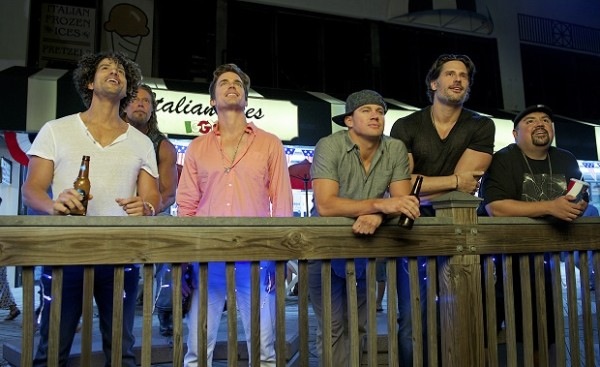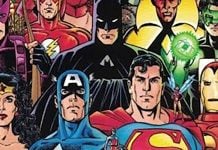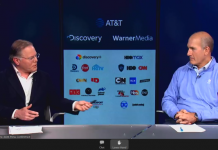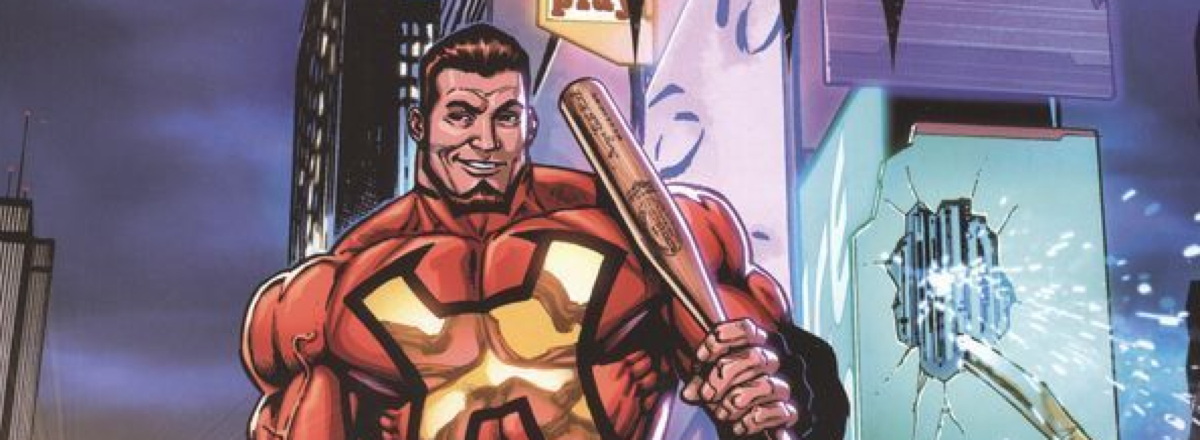Variety’s Statler and Waldorf, aka Peter Bart and Michael Fleming, have an inane piece up for Variety called — r u ready? – Comic Con, Neutered Male Performances And Ballsy Directors Ben Affleck & Luc Besson which argues that it’s over for the men:
BART: Anyone out there notice the reverse sexism that’s afflicting Hollywood? I’m glad women are getting most of the juicy roles these days, but I’m surprised that the guys have all but shriveled and disappeared. And the phenomenon is being well documented. Michael Douglas last week argued that Hollywood’s leading men have lost their masculinity. A story in The Times of London claimed that the few flashy male roles in film were mostly going to Brits and Aussies — witness Tom Holland as Spider-Man. The leading men in Magic Mike XXL and Terminator: Genisys looked like they were sleepwalking (or sleep dancing). George Clooney in Tomorrowland was formidably forgettable. And Bradley Cooper did his best to build a character in Aloha, but the script did him in. The women are even dominating animated movies – can you remember any guys in Inside Out?
“getting most of the juicy roles these days”??? So more than one or two is most?
I’m in in the post Comic-Con sleep and brain deprivation mode but after our journalism panel on Thursday night—or five years ago, as it feels—Casey Gilly and Donna Dickens were trying to explain to someone a phenomenon that I can’t remember the name of. But basically when there are more than 30% women in a crowd scene men perceive it as being MOSTLY WOMEN. Obviously old timey wimpy Hollywood curmudgeons Bart and Fleming also think that a few movies having strong female roes makes up for years and years where, say, the Academy has to scramble to find five Sscar worthy main roles for women or why a woman doing anything in Hollywod is treated like a three-eyed fish. Anyway you can read more about all of this at the Geena Davis Institute for Gender Studies website. I’m going back to sleep. Wake me up when the women are running everything.









“The women are even dominating animated movies – can you remember any guys in Inside Out?”
Appropriately, Anger and Fear? :-p
The only thing lacking balls in Hollywood is Deadline (since Nikki Finke left).
They re onto something but it’s not a one over the other thing.
I mean these guys look out at the movie and landscape and see… what? Chris Pratt? Jai Courtney?
They’re looking for the modern day equivalents of Lee Marvin and Charles Bronson. And this extends to actresses too, what are the modern equivalents of Barbara Stanwyck or Bette Davis? I think there are acouple of performers that could stand with those luminaries mentioned, but the projects just aren’t there.
I’d love to see Tom Hardy or Jen Lawrence in some meaty work, but they’re busy somewhere else.
The guys in Inside Out?
Louis C.K. (Anger)
Kyle MacLachlan (Riley’s Dad)
and of course John Ratzenberger, as a Pixar cameo.
Not as noticeable: Gonzo and Yoda as the guards.
Action stars? Dwayne Johnson, Vin Diesel?
Maybe it’s the Desmond Effect: The roles got small.
Bill Hader, Lewis Black, and Richard Kind all gave great performances in Inside Out. But those were supporting roles, so I guess they don’t count when it comes to stroking these bozos’… egos.
This is the Atlantic article that kicked off this whole debate: “The Decline of the American Actor,” by Terrence Rafferty:
ww.theatlantic.com/magazine/archive/2015/07/decline-american-actor/395291/
It focuses on the decline of the under-40 male American actor. It doesn’t say the roles are being taken over by women. It says they’re being taken over by British men. Here’s the lead:
“Earlier this year Michael Douglas mused darkly to a magazine interviewer, “I think we have a little crisis going on amongst our young actors at this point,” and Spike Lee, commenting on the “invasion” of black British actors, had some pithy observations on the subject, too: “You want talented people,” he said, and British actors’ “training is very proper, whereas some of these other brothers and sisters, you know, they come in here, and they don’t got that training.” Douglas and Lee, just like the rest of us who go to the movies, are a tad puzzled about why so many good American roles have been going to English, Irish, Welsh, Scottish, Australian, and Canadian actors. The phenomenon may have reached its unignorable peak in last year’s docudrama Selma: the parts of Dr. Martin Luther King Jr., Coretta Scott King, Governor George Wallace, and President Lyndon B. Johnson were all played by Brits.”
“BART: It wasn’t that long ago that the studios demanded a top male star to greenlight a movie – remember the era of Steve McQueen, Paul Newman and the young Redford? Today the guys can’t even get hired.”
Well, two of them are dead so that may be part of the problem.
Bart and Fleming’s lazy generalizations make make good click-bait, but they don’t withstand any sort of scrutiny — or match up to Hollywood history. Movie leading men have never been ‘All-American’ — from British-born Cary Grant to Australians Errol Flynn and Mel Gibson. Heck, even William Shatner is Canadian.
Make that “MAY make good click-bait”. Pardon my *lazy* typing.
Theory: male actors are trampling each other to get the superhero roles, characters who are more important than they are. This has devalued the cache of actor’s names across the board (unless that name is Benedict Cumberbatch because no role on earth can overshadow that name). On the other hand, not being the eponymous characters in any superhero movies means actresses names still have some cache. And because Hollywood is just beginning to be willing to take “risks” on making female-led franchise films, they compensate with “name” actresses on projects (e.g. Kristen Wiig in Ghostbusters, Charlize Theron in Mad Max: Fury Road). And for now at least, these films seem to still be adding to the actresses’ cache rather than subsuming them into the franchises.
But seriously dudes, cry more over Pixar’s SECOND female lead of their 15 films. WON’T SOMEONE THINK OF THE MENZ?
And I believe you’re referring to a study that the Geena Davis Institute did. A crowd scene in a movie will on average be 17% women. More than that and people start to perceive it as a “female-dominated” crowd. SEVENTEEN PERCENT.
Newman, McQueen and Redford spent years on the stage before they became movie stars. So did Gable, Tracy, Heston, Bogart, Pacino, De Niro, Hoffman, Hackman, and most people who became movie stars before 1990. They had real acting chops.
Most actors (and actresses) today have been in front of cameras since childhood. Instead of the stage, their training has been in TV commercials and sitcoms. Small wonder so many of them come across as shallow when they get a movie lead. They’re flimsy actors in flimsy roles.
One problem is the increasing shittiness of so many big-budget Hollywood movies. The material to develop great acting careers isn’t there. De Niro, Pacino and Hackman didn’t have to return to Broadway in the ’70s to find challenging roles. Movies were providing challenging roles. That doesn’t exist as much today.
Charlie Ryan said: “Movie leading men have never been ‘All-American’ — from British-born Cary Grant to Australians Errol Flynn and Mel Gibson. Heck, even William Shatner is Canadian.”
The difference is that Grant and Flynn didn’t try to do American accents, as Brits and Aussies do in today’s movies. As for Mel Gibson, he was born in America but grew up in Australia, and has duel citizenship, as does Nicole Kidman.
One reason for the British invasion is that the British cinema barely exists anymore. The days when studios like Hammer, Ealing and Rank were churning out British movies with British casts are long gone. If a British (or Irish or Scottish or Welsh) actor wants to make it in movies today, he has to do American movies. And most of the roles will be American characters.
If, say, Jude Law were a movie star in the ’30s and ’40s, he would play every role with his British accent, regardless of the character’s nationality (as Grant and Ronald Colman did). That doesn’t seem to be acceptable today.
I enjoyed the historical perspective of your thoughtful reply George. And while I could split hairs over the accent issue (Grant’s and Flynn’s elocution never sounded like the Queen’s English to my ear — and Gibson sure had a thick Aussie accent in the original Mad Max), I think my reaction to the Deadline piece was more about that there was not much new happening here. Movies have always been an international business. And movie stars have never been only minted in America. I hate critics like Bart and Fleming whining to make such convoluted points. And I especially hate arguments that possibly disguise xenophobia or sexism.
Can’t we just celebrate all actors, no matter their nationality or gender? I’m not checking the ID cards of those participating in the movies. I just want to be thrilled or inspired or entertained.
Movie stardom in the golden age was about personality. Audiences expected stars to retain the same personality from film to film, and speaking voices were a big part of personality. Nobody wanted to hear Cary Grant sounding like anyone other than Cary Grant. Clark Gable didn’t attempt a Southern accent in GONE WITH THE WIND because he wouldn’t have been Gable without his usual voice.
As Terrence Rafferty pointed out in his Atlantic piece, British actors in the past weren’t as good at American accents. Just listen to Laurence Olivier struggling to sound Midwestern in 1978’s THE BETSY. Like the rest of that movie, it’s pretty bad.
Comments are closed.